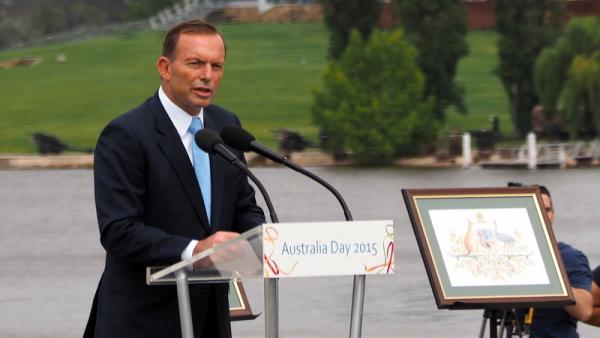
Bob Carr, Director, Australia-China Relations Institute, University of Technology Sydney |
This article appeared in The Australian on January 31 2015.
THREE months after the Abbott government was elected, the Chinese Foreign Minister Wang Yi was telling Julie Bishop that the relationship between Australia and China was damaged goods, even while cameras were still in their meeting room to record his stern lecture. Mutual trust was threatened, he warned.
Australia’s most challenging relationship was off track.
Fast forward to November last year and garlands were being hurled at Chinese President Xi Jinping as he navigated a triumphant visit and signed a free trade agreement. The bilateral relationship was upgraded to a “comprehensive strategic partnership”.
The early stumbles — now consigned to history — began with Tony Abbott’s sudden declaration a month after his election that Japan was Australia’s “best friend” in Asia. We’d never used that language before, simply ticked off Japan as a friend. Then, a month later, the Prime Minister went further, saying we were a “strong ally” of Japan. Up until then there had been no question of an alliance.
That we were tilting away from China seemed confirmed in November 2013 after the Chinese abruptly declared an air defence identification zone over the East China Sea.
Foreign Minister Bishop “called in” the Chinese ambassador and made it public. This went further than like-minded countries Singapore, New Zealand and Canada, which limited their comments to calls for restraint all round.
It was possible to attribute this to the influence of Tony Abbott’s personal adviser on security, Andrew Shearer; but whatever the reason, by the close of 2013 Australia may have been shifting from neutrality on the status of disputed islands in the East China Sea.
That was the way an angry Chinese Foreign Minister seemed to be pitching it to his Australian counterpart.
All forgotten now, after Abbott acclaimed Xi for his commitment to a rules-based international order and even to democracy. Plus the FTA. Plus the “comprehensive strategic partnership”.
So what happened? A cold warrior might say it goes to prove you lose nothing by standing up to MarxistLeninists; they treat you with respect, take you more seriously. However, a review of Australia-China relations in the 16 months of the Abbott government prepared by the Australia-China Relations Institute at the University of Technology, Sydney, suggests the hardline approach was allowed to run for only the first three months. It was then reined in. The government quickly became more attuned to the China relationship.
This diplomatic remodulation was clear as soon as Abbott went to Japan in April 2014. There was no reiteration of Japan as “best friend” or “strong ally”. Those words were retired. Then in May 2014 China positioned a deep-water drilling rig in the Paracel Islands and tension flared with Vietnam. But this time the Chinese ambassador was not called in. Bishop didn’t comment. There was a media statement with the Department of Foreign Affairs and Trade letterhead, imbued with neutrality, urging parties to ease tension.
A still bigger signal emerged, and on a neuralgic question.
In June, then defence minister David Johnston was asked whether ANZUS commits us in a conflict between China and Japan. He replied, “I don’t believe it does.” This caused no political blow-up. This was a vivid contrast with the panic around Alexander Downer’s statement in 2004 about the Taiwan Straits.
In October a statement by Bishop on the Hong Kong protests was carefully pitched. The minister recognised the right of protest but insisted it be peaceful, urging “that the people of Hong Kong can have a genuine say in their elections”. When the protests were running strong she carefully rescheduled travel arrangements that ensured she flew over Hong Kong, not into it. The Chinese breathed a sigh of relief at what they saw as respect for their core interests.
Meanwhile, a fresh dynamic was forming itself on the Chinese side. President Xi was designing a foreign policy that emphasised more robust “win-win” engagement with the world.
A flawless visit to Australia, capped with an FTA, was going to be a symbol of this new foreign policy thrust. That we were, yes, a US ally made it perhaps even more desirable. But Abbott and Bishop had paved the way. They had been careful to see that their early statements about Japan had been relegated and that responses on the South China Sea were neutral. They did not buy into Hong Kong.
And Johnston had not been hauled over the coals for his realistic reading of ANZUS applicability on the Senkaku/Diaoyu Islands.
All of which leaves both sides pondering what does a “comprehensive strategic partnership” mean? For Australia, quickly signing up to membership in the Asian Infrastructure Investment Bank would remind China and the neighbourhood that there is more to our international personality than the Australia-US alliance, inviolable though that is.
One exchange on the sidelines last year said a lot. On June 28, Hillary Clinton, promoting her memoirs, suggested in an interview with Fairfax that Australians might be “putting all their eggs in one basket” by trading so heartily with China. Here was a rare warning shot, sent in our direction by the US. Canberra responded entirely unruffled. On July 2, Malcolm Turnbull riposted that we’d willingly sell Washington all the iron ore it wants.
The orthodoxy has been that “we don’t have to choose” — that is, between the US and China. It was aptly reinforced.
Author
Bob Carr, former NSW premier and Australian foreign minister, is Director of the Australia-China Relations Institute at the University of Technology Sydney.


